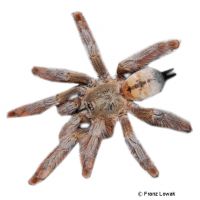Panama Blonde Tarantula (Psalmopoeus pulcher)
| Panama Blonde Tarantula Psalmopoeus pulcher | |
|---|---|
| Name | Panama Blonde Tarantula |
| Name Lat. | Psalmopoeus pulcher |
| Family | Tarantulas |
| Family lat. | Theraphosidae |
| Order | Spiders |
| Order lat. | Araneae |
| Origin | Central America |
| Habitat | Forest |
| Diet | Live insects |
| Humidity | 70-80 % |
| Behavior | Arboreal, nocturnal, aggressive |
| Keeping | Individual |
| Care Level | Difficult |
| Housing | Humid terrarium |
| Breeding | Moderately difficult |
| Life Span | 5-10 years |
| Protection | No |
| Metric Units | |
| Size | 5-7 cm |
| Temperature Day | 25-27 °C |
| Temperature Night | 20-22 °C |
| Housing Size | 30 x 30 x 40 cm |
| US Units | |
| Size | 2"-2.8" |
| Temperature Day | 77-81 °F |
| Temperature Night | 68-72 °F |
| Housing Size | 10" x 10" x 15" |
Distribution and habitat
The range of the predominantly nocturnal, arboreal Panama tree bird spiders is near the Panama Canal Zone, where they live hidden in branch forks, tree crevices, and self-dug burrows under roots.
Maintenance
For 1 animal a terrarium with a minimum size of e.g. 30 x 30 x 40 cm can be recommended. The terrarium should be placed in a quiet place without sunlight.
You need a terrarium structured with vertical cork tubes, roots and branches (hiding places and privacy), a substrate of terrarium humus, a small, shallow drinking vessel and for decoration artificial or potted plants (e.g. Ficus repens, Scindapsus aureus). Part of the substrate should always be kept slightly moist. Daily the inside of the terrarium should be finely sprayed with water (humidity), but better is a rain or mist system
| Temp. day: 25-27 °C | Temp. night: 20-22 °C | Humidity: 70-80 |
The lighting duration should be 8-12 hrs. depending on the season. Special lamps with high UV content are not necessary.
Diet
The food supply should consist of crickets, cockroaches, house crickets, maggots and grasshoppers as well as other arachnids. The prey animal is "injected" with the biting tools (chelicerae) with a digestive juice, which liquefies the protein components and the prey can thus be sucked out (extracorporeal digestion). Young animals can be offered food 1-2 times a week, adults only every one to two weeks. Under no circumstances should they be overfed, the basic rule being that the abdomen should be no more than 1½ times the size of the cephalothorax. Unaccepted food must be removed after 1-2 days. Refusal of food may indicate a natural phase of starvation or an impending molt. No food animals should be in the terrarium during molting, they could injure the spider
A regular and varied diet promotes health and prevents deficiency symptoms.
Reproduction and breeding
The smaller males can be recognized by their bulbs folded in towards the body
The female lays about 100 eggs in a prepared cocoon in her burrow about 3 months after mating. After about 10 weeks the young spiders hatch, leave the cocoon after 2 molts and some time later the nest.
Obligation to report
Make sure to inform yourself about any regulations on keeping or bans on keeping this animal in your state or home municipality (e.g. public order office). Your pet store will be happy to provide you with further information.
Important
The nimble spider can climb very well and defends itself offensively. Their irritant hairs break off when touched and can cause skin irritation and possibly corneal damage and asthma-like symptoms in the eyes. Care should also be taken when cleaning the terrarium, as irritant hairs can be stirred up by the substrate (safety goggles)
A bite is very painful, the venom is equivalent to that of a bee or wasp. Crushed or held legs can be thrown off at a predetermined breaking point and regenerate completely after 1-2 molts. They change color slightly with each molt
The terrarium must have good ventilation without drafts and meet the species specific needs. Measuring devices such as thermometers, hygrometers, etc. are necessary. The lighting has to correspond to the species-specific day-night rhythm and has to be placed in such a way that the animals cannot injure themselves. The terrarium should be locked in such a way that neither unauthorized persons can open it nor the animals can escape. Special attention must be paid to thorough hygiene and impurities must be removed regularly.
Further literature can be found in your pet store.
References
Text: petdata; Image: Franz Lowak
Source: ENGELMANN & LANGE (2011): Zootierhaltung - Tiere in menschlicher Obhut: Wirbellose, Harri Deutsch Verlag; HENKEL & SCHMIDT (2010): Taschenatlas Wirbellose für das Terrarium, Verlag Eugen Ulmer
